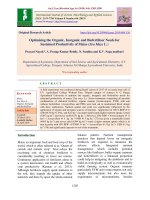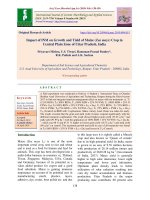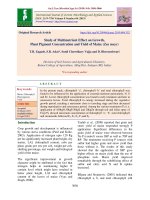DUS characterisation of corn (Zea mays L.) cultivars
Bạn đang xem bản rút gọn của tài liệu. Xem và tải ngay bản đầy đủ của tài liệu tại đây (76.93 KB, 4 trang )
Int.J.Curr.Microbiol.App.Sci (2018) 7(7): 4274-4277
International Journal of Current Microbiology and Applied Sciences
ISSN: 2319-7706 Volume 7 Number 07 (2018)
Journal homepage:
Original Research Article
/>
DUS Characterisation of Corn (Zea mays L.) Cultivars
Sabina Nasseer, Shahina A. Nagoo, Shabir, H. Wani, M. Altaf Wani, Sabiya Bashir,
Seerat un Nisa, A. Bilal, Wani, Khalid Rehman and Zahoor A. Dar
Dryland Agriculture Research Station, Sher-e-Kashmir University of Agricultural Sciences
and Technology of Kashmir -191 121 (J & K), India
*Corresponding author
ABSTRACT
Keywords
DUS, Characters, maize
composites,
morphological
characterisation
Article Info
Accepted:
28 May 2018
Available Online:
10 July 2018
Using DUS characters five composite varieties of maize (Super -1 composite,
Composite-6, Composite-8, Composite-14 and Composite-15) were characterised
through morphological features of the plant and the seed utilising fifteen descriptive
characters. The identification keys based on plant and seed morphology were
prepared. All the varieties could be distinguished on the basis of morphological
features of the plant, only three could be identified on the basis of seed characteristics.
The keys could be used to define parameters of certification and allow for determining
similarities and differences in DUS (Distinctness, uniformity and Stability) testing.
Introduction
Maize is one of the important Kharief crops
commonly grown for both higher and lower
belts of Kashmir valley. Due to nonavailability of descriptive information
concerning morphological characters for
identification of the varieties commonly
cultivated in the region, production of quality
seed is largely hampered. Morphological traits
have been widely accepted in plant variety
protection, registration and patenting as their
description has been found to be capable of
showing both identity and distinctness
(Camussi et al., 1983). Characterisation of
morphological variability also allows breeders
to identify accessions with desirable
characteristics such as earliness, improved ear
morphology etc and avoid duplication of
accessions
in
germplasm
collection.
Traditionally, numerous morphological traits
have been used to describe inbred lines and
hybrid cultivars of Maize (Zea mays L.).
Though many tools are now available to study
relationship among cultivars, including
various types of molecular markers, however
morphological characterisation is the first step
in the description and classification. Several
workers have used seed characters for
distinguishing varieties of different crops
(Burbridge 1986, Agarwal, 1990). In the
present study, an attempt was made to
formulate an identification key for maize
4274
Int.J.Curr.Microbiol.App.Sci (2018) 7(7): 4274-4277
composite varieties cultivated in Kashmir
region.
recorded on the leaf which subtended the
uppermost ear and silk colour was measured
5-6 days after silking.
Materials and Methods
Results and Discussion
The seeds of composite varieties Super-1,
Composite-6, Composite- 8, Composite- 14
and Composite-15 were planted at SKUAST
(K), Shalimar and the experimental design
was a randomised block with two replications
per variety with a row to row and plant to
plant distance of 60 cm and 20 cm
respectively. As the main goal was a practical
characterisation of maize varieties, a set of
eighteen descriptors (Table 1) were used. Data
for morphological traits were collected on
fifteen randomly selected plants per
replication.
Early plant vigour was recorded 25 days after
sowing and tassel characters were recorded
after complete tasselling. Leaf width was
Observations on various characters recorded
in five composite varieties revealed that the
varieties differed from each other. Early plant
vigour was very good in Super-1, C-14, and
C-6 whereas it was good in C-8 and C-15.
Dense Tassel texture was observed in super-1,
C-8 and C-6 while it was medium in C-14 and
C-15, based on tassel anther glume colour,
only one variety (Super-1) had purple
coloured tassel- anther glume whereas rest of
the varieties possessed light purple colour.
Tassel glume base colouration was observed
in C8, C-14, C-15 and Super-1 whereas no
colour was observed in C-6. Similarly, silk
colour was found to be purple only in C-14
while other varieties had green coloured silk.
Table.1 Morphological Traits studied
Name of the trait
A. Measurement recorded upto flowering
Early plant vigour
Tassel texture
Tassel anther glume colour
Tassel glume base color
Anthocyanin pigmentation
Leaf pubescence
Leaf orientation
Leaf colour
Leaf texture
Leaf width
Silk colour
Husk cover
B. Measurements recorded after harvest
Ear shape
Kernel row arrangement
Grain shape
Grain texture
Kernel colour
Grain size
Scale
Description of scale
1-3
1-2
1-4
1-2
1-2
1-2
1-2
1-2
1-2
cm
1-2
1-2
1-Poor, 2- Good, 3- Very good
1-Lax, 2- Medium, 3-Dense
1-Pink, 2- Green, 3-light purple4purple
1-Present2- Absent
1-Present2- Absent
1-Present2- Absent
1-Erect 2- Absent
1-Light green, 2- Green, 3- dark green
1-Smooth, 2- Leathery, 3-Normal
1-Green, 2- Purple
1-Tight, 2- intermediate
1-2
1-2
1-2
1-2
1-3
1-3
1-cylindrical, 2- cylindrical conical
1-straight, 2- regular
1-Round, 2- indented
1-Flat, 2- Beaked
1-Orange, 2- Yellow,3-White
1-Small, 2- Medium, 3- Bold
4275
Int.J.Curr.Microbiol.App.Sci (2018) 7(7): 4274-4277
Table.2 Mean leaf width and grain size for five composite varieties of maize
Varieties
Super-1
Composite-6
Composite-8
Composite-14
Composite-15
Leaf width 'cm'
9.10+0.23
8.27+0.15
8.09+0.10
8.68+0.01
9.18+0.04
All the varieties had erect leaf orientation and
therefore the trait could not distinguish the
varieties from each other. Similarly all the
varieties had medium sized leaves and no
pubescence and therefore, these two traits also
could not make any distinction between the
varieties. (Table 2)
Leaf texture was found to be normal in Super1, C-14and C-6 whereas it was leathery in C8
and C15. It was also found that none of the
genotypes
exhibited
anthocyanin
pigmentation except Super-1. This composite
also had light green leaves whereas these
were dark green in colour in the case of C14,
c8, C15 and C6.
On the basis of ear shape, Super-1 could be
distinguished from other varieties because of
its cylindrical ears whereas other varieties
possessed cylindrical- conical ears. Similarly,
C6 could be characterised by intermediate
type of husk cover from other varieties which
had tight husk cover. Regular arrangement of
kernel rows was observed only in C6 whereas
other varieties had straight arrangement of
kernel rows.
The measurement taken after harvest were
also variable for the varieties. Most
discriminating grain characteristics was
kernel colour that was found to be white in
case of C8, Orange in Super-1, C14 and C6
and yellow in C15. Beaked grain texture was
observed in C15 and rest of the varieties had
flat grain texture. Similarly Indented grain
shape was observed in C8 whereas C14, C15,
Grain size 'g'
28.11+0.34
27.64+0.02
31.00+0.50
26.40+0.32
25.11+0.10
C6 and Super-1 had round grains. C14 was
characterised by medium sized grains
whereas, super-1, C15, C6 and C8 had bold
seeds.
Morphological traits traditionally have been
used as descriptors. It is likely that their use
will continue because they are omnipresent in
agriculture (Smith and Smith, 1989b). All the
varieties could be resolved on the basis of
morphological features whereas only three
cultivars could be resolved on the basis of
seed characters.
References
Agarwal, R.L. and Pawar, A. 1990.
Identification of soybean varieties on
the basis of seed and seedling
characters. Seed Research 18: 77-81
Burbridge, M.J., Batey, J.L., Campbell, W.P.,
Skerrit, J.H. and Wrigley, C.W. 1986.
Distinction between barley varieties by
grain characteristics, electrophoresis,
chromatography and antibody reaction.
Seed Science and Technology, 14: 619629
Camussi, A. Spagnoletti Zeuli, P.L. and
Melchiorre, P. 1983. Numerical
taxonomy of Indian Maize populations:
genetic distances on the basis of
heterotic effects. Maydica, 28: 411-424
Smith. J.S.C and Smith, O.S. 1989a. The
description and assessment of distance
between inbred lines of maize: I, The
use of morphological traits as
descriptors. Maydica 34: 141-150
4276
Int.J.Curr.Microbiol.App.Sci (2018) 7(7): 4274-4277
Smith. J.S.C and Smith, O.S. 1989b. The
description and assessment of distance
between inbred lines of maize: I, The
use of morphological, biochemical and
genetic descriptors and a scheme for the
testing of distinctiveness between
inbred lines. Maydica 34: 151-161
How to cite this article:
Sabina Nasseer, Shahina A. Nagoo, Shabir, H. Wani, M. Altaf Wani, Sabiya Bashir, Seerat un
Nisa, A. Bilal, Wani, Khalid Rehman and Zahoor A. Dar. 2018. DUS Characterisation of Corn
(Zea mays L.) Cultivars. Int.J.Curr.Microbiol.App.Sci. 7(07): 4274-4277.
doi: />
4277









